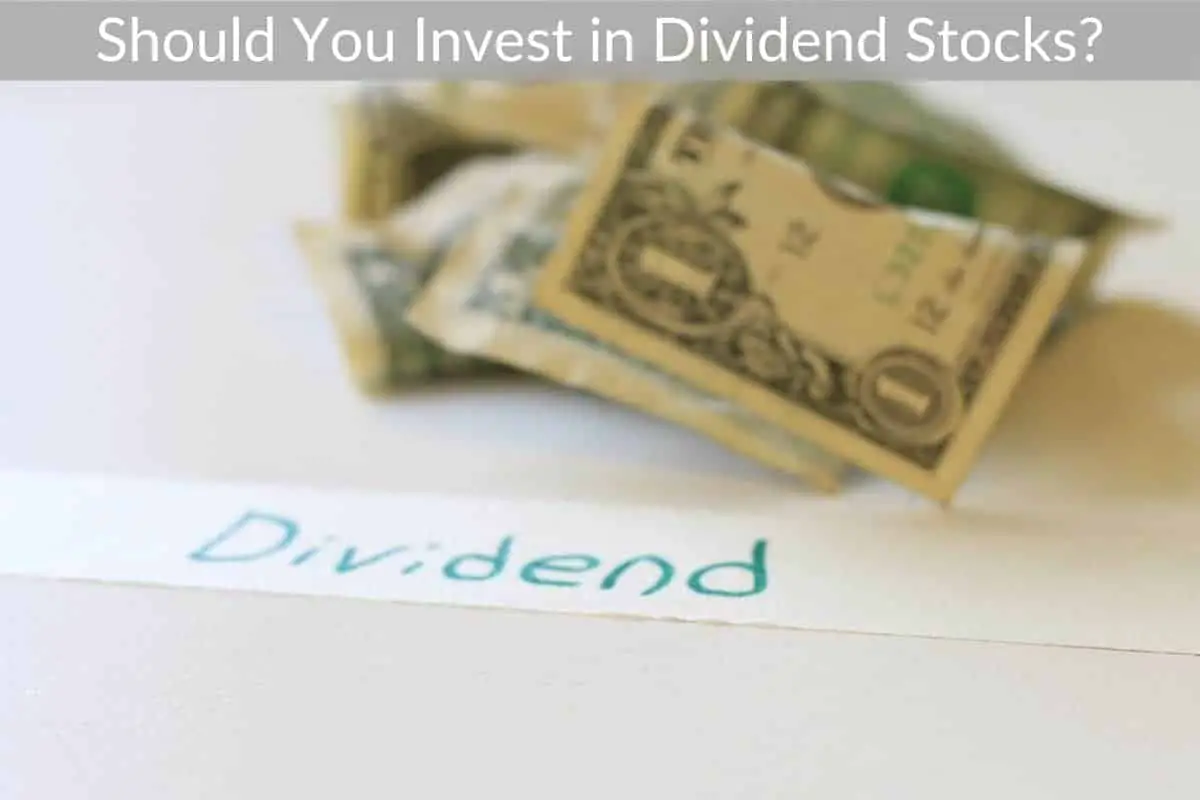Table of Contents
*This post may contain affiliate links. As an Amazon Associate we earn from qualifying purchases.
Dividend stocks are commonly confused with free money. While they are not, they can still make you significant gains. So, should you invest in dividend stocks?
Historically, about 40% of investment returns from the stock market have been generated by dividends so investing in these stocks is a good idea. Additionally, dividends can create a passive income stream of cash and the dividend investor can do with that cash as they please.
In this article, I’m going to explain the pros and cons of investing in dividend stocks so you can make an informed decision when it comes to whether or not dividends are right for you.
Should You Invest in Dividend Stocks?
To get us started and to make sure we all understand today’s topic about the pros and cons of dividend stocks, I’m going to run through 3 quick definitions.
- Dividend Investing: one of many different types of investment strategies out there. First of all, the strategy focuses on building and maintaining a portfolio of dividend stocks. Furthermore, it is typically associated with a long-term, buy-and-hold investment approach.
- Dividend Stocks: Shares of a dividend stock represent partial ownership in a company. Specifically, a company that pays the owners of its stock dividends.
- Dividends: A dividend is a distribution of economic value to owners of a dividend stock. The issuance of dividends can come in different forms.
The form we are talking about today is the most typical. We are talking about cash dividends.
Dividends are paid for several reasons. Most importantly, to reward investors.
5 Advantages Of Stock Dividends
I like investing in stocks for cash dividends. So, I can come up with plenty of benefits of dividend investing.
Today, I’m going to stick with 5 of the most important reasons to invest in dividend-paying stocks.
1. Passive Dividend Income Stream
Dividend stocks pay cash to their shareholders. It’s one way dividend investors make money.
Sometimes dividends are referred to as dividend income, passive income, investment income, or portfolio income.
Whatever you want to call it. Dividends represent cash in an investor’s pocket. Once received, the investor can do with that cash as he or she pleases.
Many investors believe they can count on receiving dividends. Rather than hoping for share price appreciation.
Pros Of Dividend Stocks: Receiving Cash Creates Options
Spend it, save it, or reinvest it. They are the 3 main options. Furthermore, there is less need to sell stock to get cash.
Most importantly, once the investor receives their cash dividend. It can never be taken away.
Finally, research shows that over the long term about 40% of the stock market’s total return comes from dividends.
This leads us to our next advantage of dividend vs non-dividend stocks…
2. Solid Total Investment Returns
In time, the price per share of a dividend stock will typically rise. This provides the dividend investor with an additional return on investment.
Over and above the cash dividends received. It comes from share price appreciation.
The combination of making cash dividends and share price appreciation makes for an attractive total return on investment potential.
3. Dividend Reinvestment For Compounding Returns
I mentioned that one option for dividends received is reinvestment. Also called dividend reinvestment , or DRIPs. That stands for dividend reinvestment plan.
By reinvesting dividends regularly, the investor can take advantage of compounding returns.
This means a dividend investing strategy generates cash dividends which are then reinvested back into dividend stocks to generate more dividends from the past dividends that have been received.
Compounding dividends is very powerful for building wealth over the long-term. Some investors call it the dividend snowball effect.
4. Hedge Against Inflation
Dividend stocks provide a hedge against inflation. Inflation is the steady increase in prices for goods and services that we consume.
We haven’t had high inflation over the past 10-20 years, but there is concern it will return because of massive government spending.
Pros Of Dividend Stocks: Dividend Increases
Dividend stocks hedge or offset inflation because of dividend increases since it is normal for a company to increase its stock dividend regularly.
Thus, when prices for goods and services rise due to inflation, so do our dividends. Often, dividends will rise by an amount more than the inflation rate.
5. Preferential Tax Treatment
Dividends have historically received favorable tax treatment as compared to the tax rates on ordinary income.
Tax laws are always changing and everyone’s tax situation is different, but to generalize, tax rates on interest income, money made from a job, or business earnings can exceed 40% in some cases.
This is especially true when you include social security tax on earned income.
On the other hand, qualified dividends are taxed at a much lower rate. The exact rate depends on your specific tax situation.
5 Disadvantages Of Dividend Stocks
Like I said at the beginning, I prefer dividend investing. But, I know there are drawbacks to dividend stocks.
I choose to accept them because for me, the pros of dividend stocks outweigh the cons.
You may form a different opinion once you read about the top 5 disadvantages of dividend stocks…
1. Tax Inefficiency
We just discussed the preferential tax treatment that dividends receive, but there is a different side to the argument about the tax effectiveness of dividends.
Specifically, when we compare dividend stocks vs growth stocks, we find that dividends are taxed twice. Also called double taxation.
Cons Of Dividend Stocks And Taxes: The First Tax
First, they are taxed when the company paying the dividend earns money. Corporate profits are the source of dividend payments made to you and me.
Cons Of Dividend Stocks And Taxes: The Second Tax
Second, dividends are taxed again when the investor receives their dividends. Because taxes are due on dividend income when it is received.
Taxes On Dividend Stocks Vs Growth Stocks
On the other hand, growth companies take their earnings and reinvest them into their business. Earnings are only taxed at the corporate level.
Business investments are made by companies to generate more profits. In turn, those profits should drive up the price of a growth stock.
Thus, creating capital gains for the investor, not paying dividends.
As long as the growth stock investor holds their shares, no further tax is due. Capital gains taxes are deferred until the shares are sold.
Tax Benefits Of IRAs For Dividend Stocks
Buy and hold dividend stocks in an IRA. Then, much of the additional tax burden of dividend stocks can be reduced or taxes are entirely avoided.
This depends on the type of IRA you open.
2. Investment Risk
Dividend stocks carry investment risk, especially when compared to other income-generating investments such as savings accounts, certificates of deposit, and bonds.
Because stock prices can and will go down (sometimes by a lot), this will create investment losses even for a dividend stock investor.
On the other hand, savings vehicles and bonds will typically hold their value better during difficult economic times.
3. Sector Concentration
Dividend stocks are clustered in certain industries and stock market sectors. Thus, dividend investors must pay careful consideration to dividend stock portfolio construction.
This means ensuring adequate diversification, so, all or most of the stocks held, do not reside in the same or similar industries.
Furthermore, by investing only in dividend stocks, an investor may pass on some excellent investments.
Specifically, investments in companies whose stocks do not pay dividends (for example, stocks like Amazon, Tesla, and Facebook) should not be ignored.
The stocks of these companies have done very well for their investors, while dividend investors have missed out.
So, growth stock investors may tell you dividends are irrelevant, and sometimes they are right. This shows another of the dividend stocks vs growth stocks tradeoffs.
4. Dividend Policy Changes
Negative dividend policy changes by company management can be very harmful to the dividend investor. They can be another reason not to invest in dividend stocks.
On one hand, some companies have the policy to pay dividends and increase them regularly, and they do so without a hitch.
In contrast, when a dividend-paying company encounters difficult economic times, or management decides they have better uses for their cash rather than pay dividends then, a company may choose to reduce its dividend.
In the worst case, some companies might even eliminate the dividend entirely.
Not only will the dividend investor suffer a drop in their future portfolio income, but these actions tend to come with big decreases in the dividend stock’s share price.
Thus, dividend reductions and eliminations are a “lose-lose” situation for a dividend stock investor.
5. Investment Research & Knowledge
Investing in high-quality dividend stocks requires investment research, and knowledge about how to construct a dividend portfolio.
Specifically, a successful dividend investor must be able to execute their dividend investing strategy on 4 levels.
Level 1: Cons Of Finding Dividend Stocks
First of all, the dividend investor must know how to find and identify dividend stocks. There are certain dividend metrics to look for and specific places to find good dividend stocks.
Level 2: Cons Of Analyzing Dividend Stocks
Furthermore, a dividend investor must know how to analyze dividend stocks once identified and be comfortable reading financial reports.
Some questions to find answers to include:
- Is the company’s dividend safe from a reduction?
- Does the stock price represent good investment value?
- Will management increase the dividend in the future?
- What is the dividend payout ratio?
Level 3: Cons Of Constructing A Dividend Stock Portfolio
Then, an investor’s dividend stocks must be assembled into a portfolio.
So, knowing how to build a diversified portfolio paying dividends is critical to reduce investment risk and to provide for monthly dividend income.
Level 4: Cons Of Monitoring Dividend Stocks
Finally, circumstances change. Some dividend stocks underperform, others do so well that they must be sold to rebalance the portfolio.
Dividends are received and to benefit from the compounding of investment returns, they must be reinvested wisely.
So, a good dividend investor must continue to monitor his or her stocks and their overall portfolio.
Managing Dividend Stocks Vs Growth Stocks
In fairness, this is not too different when comparing dividend stocks vs non-dividend stocks, or dividend stocks vs growth stocks.
These other investment approaches require research, analysis, and monitoring too.
Pros And Cons of Dividend ETFs And Funds
Finally, a dividend investor may choose to execute a dividend investing strategy in an easier way, through the use of mutual funds or exchange-traded funds (ETFs).
Doing so reduces the need for research and knowledge, which was the last of our 5 disadvantages of stock dividends investing discussed today.
Final Thoughts
Should you invest in dividend stocks? As you can see there are a lot of pros and cons related to dividend stock investing.
Deciding whether or not to invest in dividend stocks comes down to you. So, be diligent and do your research to ensure you’re putting your money in the right place!

